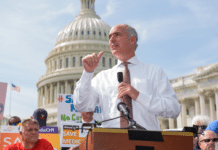
The average credit score of Americans declined for the first time in a decade, with the number of missed borrower payments and consumer debt levels rising, according to credit scoring firm FICO.
A FICO score is used by many U.S. lenders to assess a prospective borrower’s credit risk. As of October 2023, the national average FICO score was at 717, which is one point lower than October 2022 and “reflects the first time the metric has decreased in a decade,” FICO said in a blog post on March 6.
“Given that the FICO score is a lagging, not leading, economic indicator, this suggests that the effects of high interest rates and persistent inflation may be starting to weigh on consumers, especially those already struggling to manage their finances.”
The one point drop “is driven by increases in missed borrower payments and consumer debt levels,” the organization stated.
By October 2023, more than 18 percent of Americans had a 30-day or worse past-due payment on one or more credit accounts the previous year, up from four percent in April 2023.
“The apparent cumulative impact of higher interest rates, elevated consumer prices, and economic uncertainty has put a financial strain especially on those consumers who heavily rely on credit cards to cover everyday expenses. This can lead to higher credit card utilization and subsequent defaults on credit card payments.”
Consumer debt is now higher than what it was pre-pandemic. FICO cited data from the Federal Reserve Bank of New York, showing that credit card balances exceeded $1 trillion last fall, which is roughly $3,100 per individual.
Elevated inflation and the high cost of obtaining and carrying debt “appears to be causing consumers, especially those with limited cashflow, to carry increased levels of debt,” FICO said.
New credit activity was found to have slowed down. As of October, 44.4 percent of Americans opened at least one new credit account over the past year, down from 45.5 percent in April and 47.2 percent in October 2019.
FICO speculated that the decline between April and October last year was likely due to a fall in mortgage origination volumes.
During an interview with CNN, Gus Faucher, chief economist at the PNC Financial Services Group, said that some households are “under stress.”
“Inflation has hit lower-income households harder, and many of them have spent down their stimulus savings.” He doesn’t see the dip in FICO scores as a “terribly concerning” matter.
Credit card troubles
According to the New York Fed, credit card balances of Americans by the end of December 2023 stood at $1.13 trillion. Approximately 8.5 percent of credit card balances transitioned into delinquency, it said. Serious credit card delinquencies jumped among people of all age groups, specifically among younger borrowers.
“Credit card and auto loan transitions into delinquency are still rising above pre-pandemic levels,” said Wilbert van der Klaauw, economic research advisor at the New York Fed. “This signals increased financial stress, especially among younger and lower-income households.”
A larger number of U.S. consumers are having a tough time paying off credit card dues every month. Roughly 46 percent of credit card holders do not pay off their dues in full each month, according to data from Bankrate in December. This is up from 39 percent a year back.
Around 43 percent of those with credit card debt are not aware of the interest rates charged on their cards. “People may not be fully aware of how expensive credit card debt — or other alternative loans — are, and that interest on these loans compounds,” Michaela Pagel, a Columbia Business School professor, said to Bloomberg.
“If somebody rolls over $5,000 of credit card debt over five years, it balloons into $12,441 at 20 percent interest.”
A November survey from Bankrate found that 49 percent of American cardholders carried credit card debt from month to month, which is up 10 percentage points from 2021.
“Emergency expenses is the leading cause for incurring credit card debt, with 43 percent of those carrying the debt pointing to unexpected emergency expenses as the reason.”
Another report from Bankrate published in February found that 36 percent of U.S. adults have more credit card debt than emergency savings, the highest level since 2011 and tied with last year. Among the 35 percent who would borrow money to meet an emergency, 21 percent did so with their credit cards.
Millennials and Gen X were found to likely have more credit card debt than emergency savings compared to baby boomers and Gen Z individuals.
“Recognizing that the cost of carrying debt has increased significantly in the past two years and the insufficient level of emergency savings, more Americans are focusing on both paying down debt and boosting emergency savings simultaneously, rather than one to the exclusion of the other,” said Greg McBride, chief financial analyst at Bankrate.
“Having a direct deposit from your paycheck into a dedicated savings account automates the savings, allowing you to channel your take home pay toward the goal of paying down debt.”

















